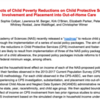Because of a collaboration with Columbia University and UW-Madison, we have answers to these questions.
By Peter Peter Pecora, Casey Family Programs, March 17, 2023 -
Overview
The National Academy of Sciences (NAS) recently released a “roadmap” to reduce child poverty by as much as half through the implementation of a series of social policy packages. The aim of this study was to simulate the reductions in Child Protective Services (CPS) involvement and foster care placements that are likely to result from implementation of three of the NAS policy packages. In addition to the introduction of a child allowance, the proposed policy packages include reforms to the EITC, SNAP, and the federal minimum wage, among others. (The NAS poverty reduction packages are summarized on page 2 of the study abstract document, and pp. 79-80 in the article.)
Reduction in CPS Investigations
Depending on the policy package and simulation specifications modeled, we find that the child poverty reductions expected under the NAS recommendations have the potential to reduce CPS investigations by 11.3% (Package 2, low threshold) to 36.4% (Package 4, high threshold) -- constituting approximately 386,000 to 1.2 million fewer CPS investigations per year.
Moreover, we find particularly large reductions in CPS involvement that would reduce racial disproportionality substantially. We estimate an 18.7 to 42.8 percent reduction in investigations for Black children, and 13.3 to 47.6 percent for Hispanic children, compared to 6.7 to 27.9 percent for white children.
Reduction in Out-Of-Home Care Placements
Our simulated effects on CPS involvement imply that 16,000 to 23,000 fewer children would be removed from their home and placed in out-of-home care each year.
The project purchased a special license so that this article can be shared with anyone.
Reference:
Pac, J., Collyer, S., Berger, L.M., O’Brien, K., Parker, E., Pecora, P.J., Rostad, W., Waldfogel, J. & Wimer, C. (2023). The effects of child poverty reductions on child protective services involvement and placement into out-of-home care. Social Services Review,97(1), 43-91.
Attachments:
Columbia_UW-Madison_Casey Family Programs Poverty Reduction Study Abstract_3-16-23.pdf
For more information, contact:
Peter J. Pecora
Managing Director of Research Services
Pronouns: He/His
P 206.270.4936
casey family programs | casey.org



Comments (1)